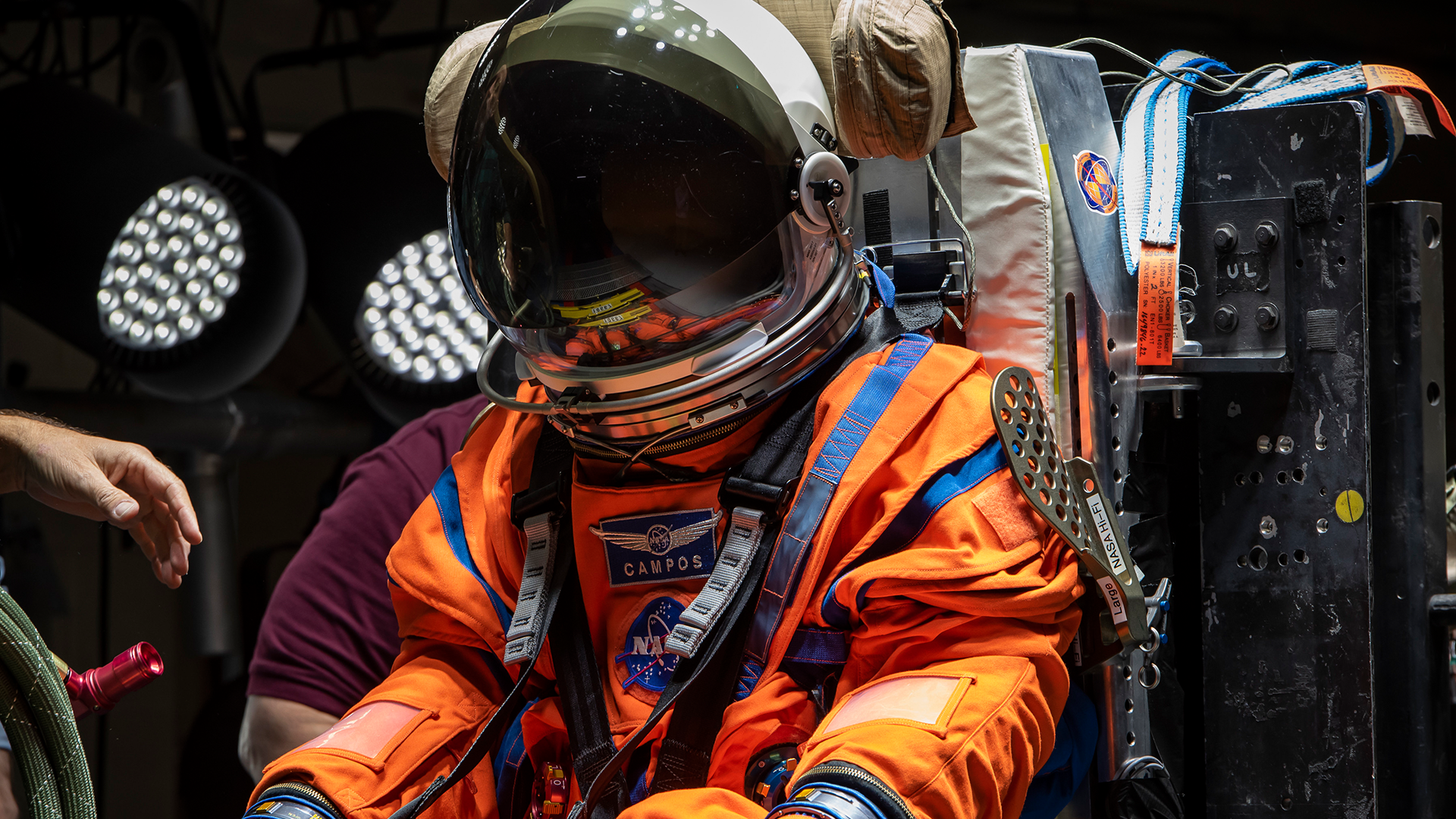AFRL helps NASA test equipment for Artemis II mission
WRIGHT-PATTERSON AIR FORCE BASE, Ohio (AFRL) – The Air Force Research Laboratory, or AFRL, and NASA worked together over the last two weeks of April 2023 along with other industry partners, such as Lockheed Martin, to test the most current iteration of an astronaut crew seat and flight suit that will be used in the Orion spacecraft during future missions to space.
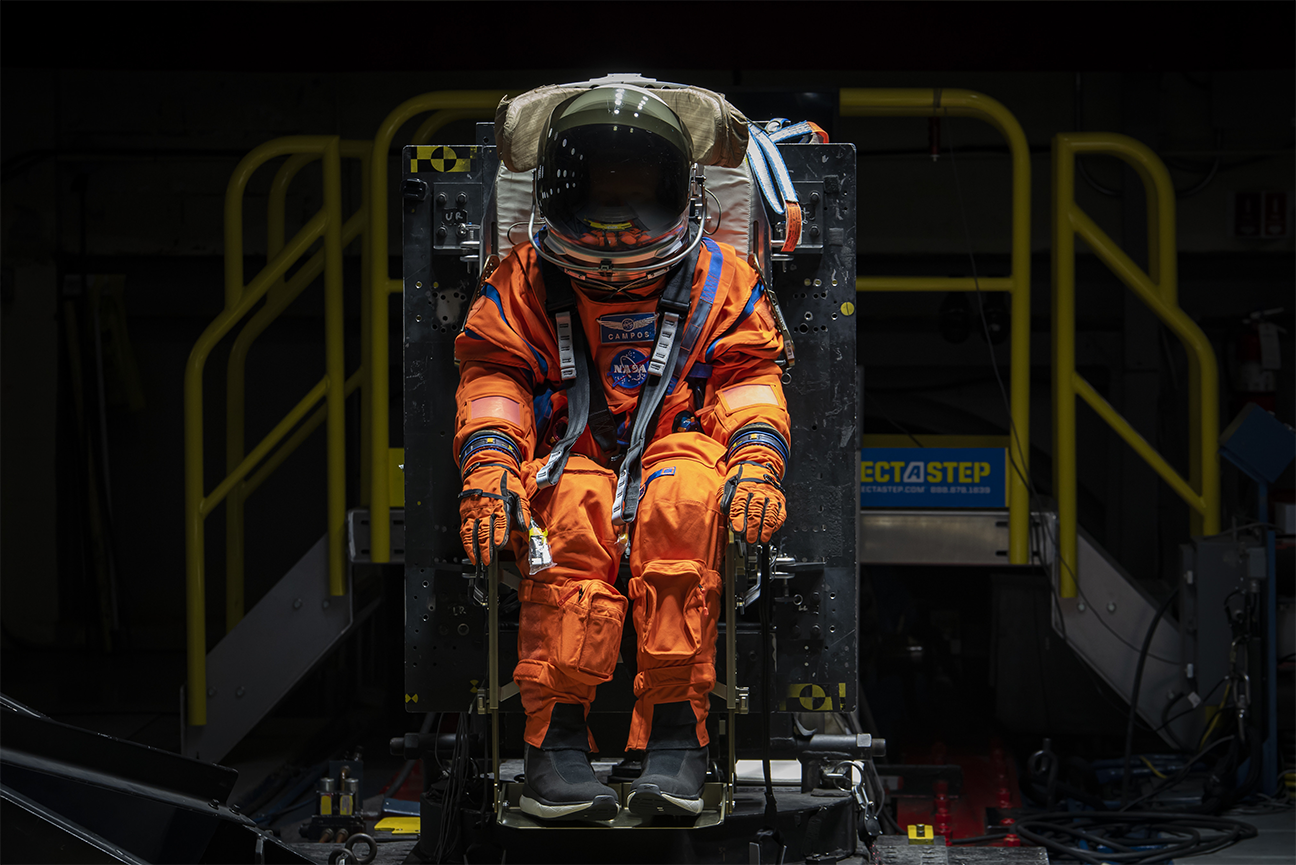
Campos, a fire and rescue training manikin, at the sled test facility at Wright-Patterson Air Force Base, Ohio, April 17, 2023, where Air Force Research Laboratory, or AFRL, and NASA staff test the seat and flight suit for safety measures. AFRL and NASA, along with other industry partners, such as Lockheed Martin, tested the most current iteration of an astronaut crew seat and flight suit that will be used on the Orion spacecraft during the next mission to the moon under the Artemis Program. The manikin used in the testing was Campos, named after the legendary Arturo Campos, an electrical engineer who was instrumental to saving the Apollo 13 crew. Campos is accurately weighed and has the appropriate density of a human for testing. (U.S. Air Force photo / Rick Eldridge)
“NASA came to us actually several years ago, to work with them on development of the Orion spacecraft capsule [to test the] suit for the astronauts and the seating system with the emphasis on the structural design of the seat and the restraint configuration,” said Chris Perry, senior biomedical engineer, Biodynamics Section, 711th Human Performance Wing.
The Horizontal Impact Accelerator, or HIA, at AFRL’s Biomedical Impact of Flight Branch, tested multiple landing scenarios to gauge how the high-energy, low duration events inherent to the Orion spacecraft’s landings might affect the crew of the Artemis II mission. Using only parachutes to reduce speed, the Orion crew module will slow from nearly 25,000 miles per hour to around 20 during reentry and splashdown in the Pacific Ocean.

The Air Force Research Laboratory, or AFRL, and NASA work together at the sled test facility at Wright-Patterson Air Force Base, Ohio, April 17, 2023, along with other industry partners, such as Lockheed Martin, to test the next replica of a seat and flight suit that will be used on the Orion space capsule during the next mission to the moon. (U.S. Air Force photo / Rick Eldridge)
“This horizontal accelerator is currently the only known facility of its kind that can conduct extensive biodynamic research on instrumented [anthropometric test device, or] ATDs and volunteer human subjects,” Perry said.
The HIA allows AFRL and NASA to assess various landing impact scenarios across all three — x, y and z — coordinate axes of the seat and enable researchers to examine how the seats and flight suits interact with one another and what affect those interactions may have on the crew. This allows crew safety personnel to address any issues that may present themselves in a more cost-effective manner than other testing options.
Another advantage is being able to run the system in a laboratory environment, where multiple tests in various orientations and configurations can be assessed. This gives the testing team an idea of potential areas of crew injury and allows changes to be made.
“This saves lives, equipment and money,” Perry said. “It’s a conservative assessment option. That way if they see a problem with a design after a laboratory facility test, it’s easy to go back and make changes and come back in and test.”
The objective of the testing, Perry said, is to gauge the structural integrity of the suit and the seat and to ensure its safety.
“That seat we’re going to test is a replica of the flight design that will be used in future Artemis missions. It’s all for the Artemis program. The testing here is really key to that next step of a human occupant flying in the Orion spacecraft as part of their continuing missions to go to … the moon and beyond during the whole Artemis program.” ~ Chris Perry.
Testing facility
The two primary objectives are: No. 1, structural integrity of the suit and its critical components, and No. 2, to evaluate crew injury risk while suited and restrained in the Orion seat by using specialized anthropometric test devices, or ATDs, also known as a crash test dummy, said Perry.
The team tested the high-impact sled by adjusting the orientation and seat, and strapping in Campos, a manikin named after the legendary Arturo Campos, an electrical engineer who was instrumental to saving the Apollo 13 crew. Campos is a fire and rescue training manikin, and it is accurately weighed and has the appropriate density of a human. After traveling 1.4 million miles through space during the Artemis I mission, Campos was accelerated down the HIA track in the new Orion Crew Survival System flight suit to confirm it could withstand the most severe possible landings. In a second set of tests, Campos was replaced with small, medium and large instrumented ATDs for more detailed crew injury assessment.
“Then we compare the output or the data we collect from the ATD,” Perry added. “We compare that to injury criteria.”
The Air Force risk values must be 5% of risk of injury or lower, Perry said, and NASA is in the 1-5% range, or less. With this being the final design of the seat and the suit, the teams wanted to ensure the two integrated properly during simulated extreme landings.
“The worst-case scenarios for the spacecraft during landing had been determined by computational modeling,” Perry said. “NASA asked our facility to duplicate those real-world impact conditions on our impact sled in a more controlled environment.”
In addition to the occupant injury criteria, AFRL and NASA work with other AFRL technology directorates on sensors, materials and manufacturing and heat shield technology.
“So, there are a lot of the different technology directorates in AFRL that worked with NASA on multiple programs besides just what our biodynamics lab does — in terms of occupant protection and human injury, tolerance and how to provide the best seat in spacesuit and restraint configuration that we can protect them, as well as during all phases of their mission,” Perry said.
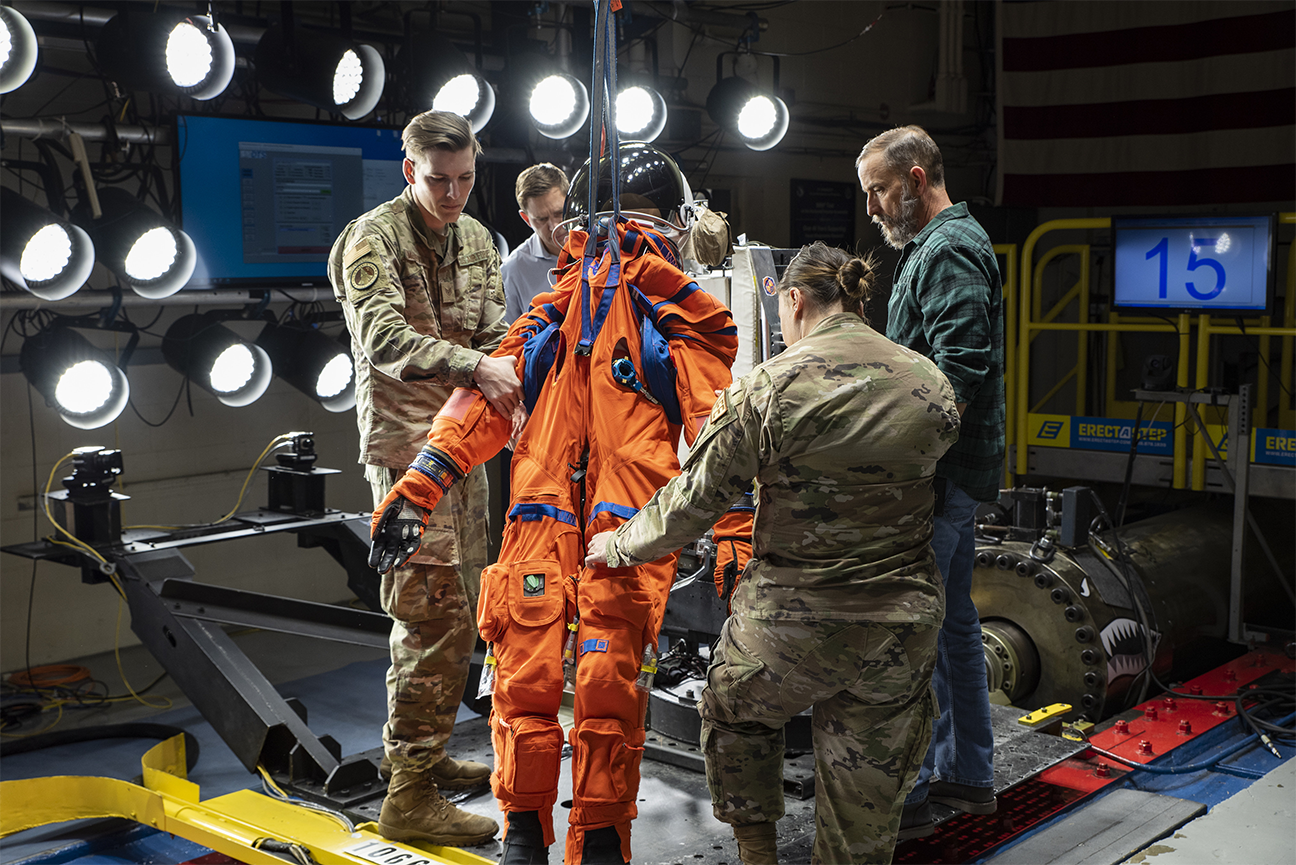
The Air Force Research Laboratory, or AFRL, and NASA staff hoist Campos, a fire and rescue training manikin, into the seat at the sled test facility at Wright-Patterson Air Force Base, Ohio, April 17, 2023. AFRL and NASA, along with other industry partners, such as Lockheed Martin, tested the most current iteration of an astronaut crew seat and flight suit that will be used on the Orion space capsule during the next mission to the moon under the Artemis Program. The manikin used in the testing was Campos, named after the legendary Arturo Campos, an electrical engineer who was instrumental to saving the Apollo 13 crew. Campos is accurately weighed and has the appropriate density of a human for testing. (U.S. Air Force photo / Rick Eldridge)
Additionally, the role of Lockheed Martin, the prime contractor for the Orion spacecraft, has been to design the vehicle itself, including the critical thermal protection system on the exterior and to the crew compartment on the interior.
“We designed and built the seats, the restraints and from the onset, we had to confirm that those two components: the seats [and] the restraints, had to work with the suit to make sure human beings fit into all those systems together,” said Mark Baldwin, biomechanical engineer and occupant protection specialist at Lockheed Martin Space. “And then on top of that, we also designed a one-of-a-kind, unique impact attenuation system because we’re going to land under variable conditions in the water.”
With today’s technology, Baldwin, whose role was to help design the interior, said they are better equipped with tools to reduce the severity of the landing, specifically to every seat for any size crew member in the seats.
“And for the first crewed Artemis II flight, to just give an example, we have somebody who’s a small female, and we have a large male, so we already run the gamut of size on the very first mission,” Baldwin added.
The new generation of spacecraft have many lessons learned from previous accidents and expertise developed in the automotive and Air Force communities, Baldwin said.
Comparing impact simulations
“The facilities here are quite unique,” said Dustin Gohmert, Orion crew survival engineer at NASA. “This horizontal accelerator is one of only two or three of its kind in the whole world.”
Having worked with AFRL when exploring upgrades to shuttle seats, Gohmert said the team looked at how things could be made more tolerable in an accident.
“This is probably the sixth or seventh time we have been to Wright-Patterson in the last decade,” Gohmert said. “Each time we learn a little bit more and we would go off for a couple of years and start tinkering.”
When the system was first installed in the 70s, Perry said, they wanted to be able to test heavier items and mount heavier equipment on the sled.
“If it’s a lot heavier, that means you got to have a lot more energy to get it up to a given velocity,” Perry said. “So, when they first installed our system back in the 70s, the thought process was to get the biggest system so we’re not limited on the amount of energy we might need to apply to a piece of equipment to test whether it’s safe or not.”
One of the original founders of the biodynamics laboratory at Wright Patterson Air Force Base developed the sled test facility, Baldwin said.
“[It was] largely to investigate what the human body does under acceleration, and specifically what we call transient or very quick acceleration — similar to an ejection or hard landing in rotorcraft,” Baldwin said. “Well, as it turns out, spacecraft have similar transient events. And we want to confirm that if we put our astronauts into our specific environments to our suit in our seat, that we can keep them safe.”
A lot of the research, and the characterization of what the human body could tolerate from an acceleration standpoint, came from this lab, Baldwin said.
“The history of the lessons learned from the Apollo and Shuttle programs are really what we take forward into the Orion spacecraft,” Baldwin said. “To the outsider, you may see just another capsule … But beyond the obvious upgrades and computational capability, we also have all this background biomechanics [and] research coming from the biodynamics lab that helps us design these systems specifically to improve safety.”
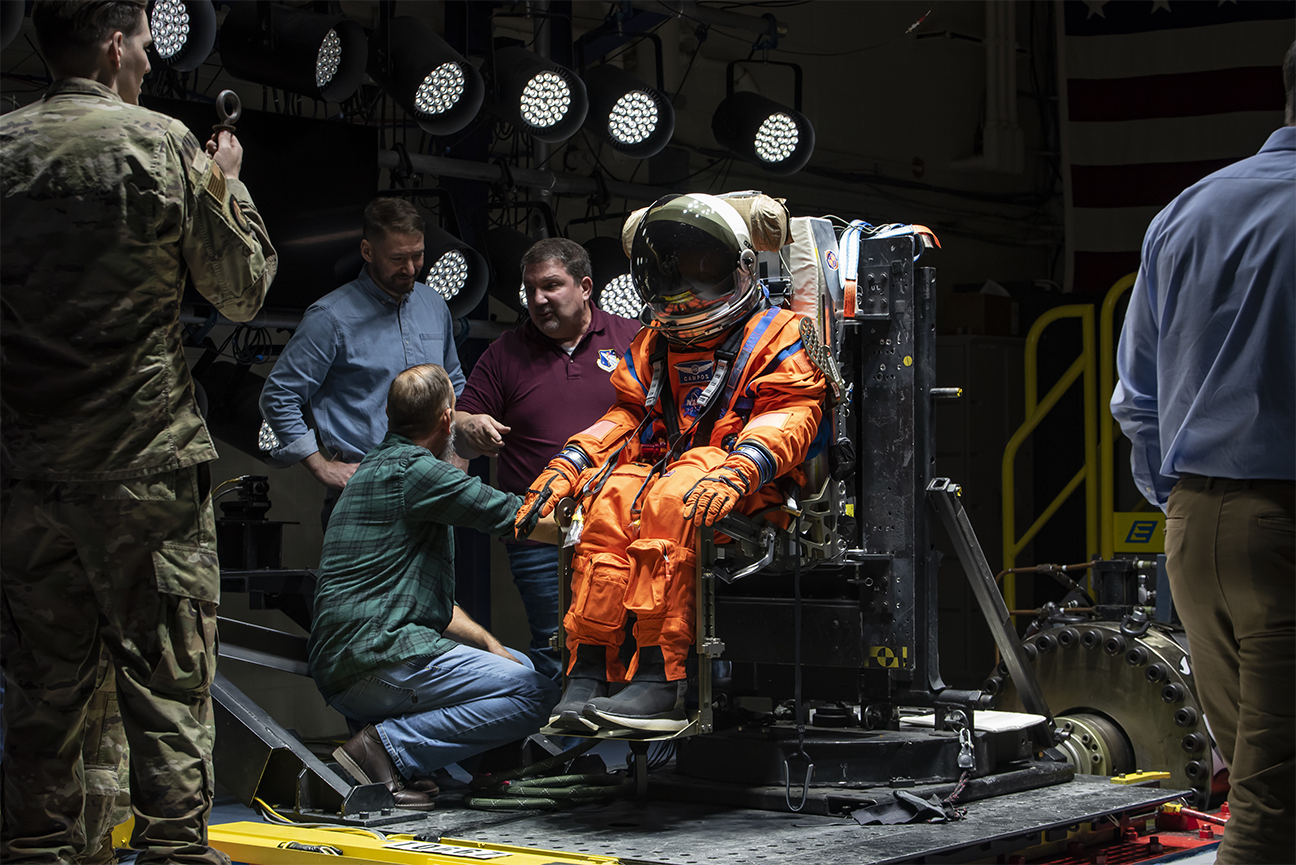
The Air Force Research Laboratory, or AFRL, and NASA staff adjust Campos, a fire and rescue training manikin, in the seat at the sled test facility at Wright-Patterson Air Force Base, Ohio, April 17, 2023. AFRL and NASA, along with other industry partners, such as Lockheed Martin, tested the most current iteration of an astronaut crew seat and flight suit that will be used on the Orion spacecraft during the next mission to the moon under the Artemis Program. The manikin used in the testing was Campos, named after the legendary Arturo Campos, an electrical engineer who was instrumental to saving the Apollo 13 crew. Campos is accurately weighed and has the appropriate density of a human for testing. (U.S. Air Force photo / Rick Eldridge)
Baldwin said the expertise and Air Force connections are much appreciated.
“These guys have actually shown us many things year after year,” Baldwin said. “This is our sixth time at this particular lab. They’ve been so knowledgeable and so helpful to get us to this point.”
NASA and AFRL, particularly, the human impact lab, have a long history of working together on different programs since the 60s and 70s, such as the Apollo program.
“We have similarities in terms of the impact environment that the Air Force pilot would see, or the NASA astronaut would see,” Perry said.
The similarities are in terms of the space capsule landings, Perry added. Depending on the orientation of the landing, there are impact accelerations that an Air Force pilot experiences when they “punch out” of an aircraft. The maximum acceleration for an Air Force pilot and an astronaut are very similar.
“Initially NASAs was more multiaxial, in terms of a lot of different directions of impact, where the Air Force has mainly focused on ejection,” Perry said. “But over the years, we’ve really come to terms on what injury criteria [and] acceleration vectors at different orientations coming into the body.”
Perry compared the impact research to that of the automotive research companies, as they have a high-speed sled.
“I guess probably one of the big differences between our sled and some of the automotive research is that they get their cars up to an initial velocity by propelling the car down the track, and then it hits a fixed, rigid barrier,” said Perry. “So, they’re measuring what’s happening to that occupant during the crash and also with the airbags, which are there to protect it.”
But Perry said if the protective gear is made too aggressive, it can have an adverse effect.
“You don’t want to go overboard with too much of the technology because you could actually turn around and injure them,” Perry added.
They also have a similar sled to conduct impact testing, Perry said. Where the sled is at rest and then accelerated.
“Which is what our test facility is set up to simulate — our horizontal sled,” Perry said. “We have a vertical tower set up to simulate various phases of an aircraft ejection or, say, a hard landing of like a fixed wing, heavy bomber transport aircraft or helicopters.”
The facility is set up to test various impacts, such as hard landings, auto rotation and slam can be simulated.
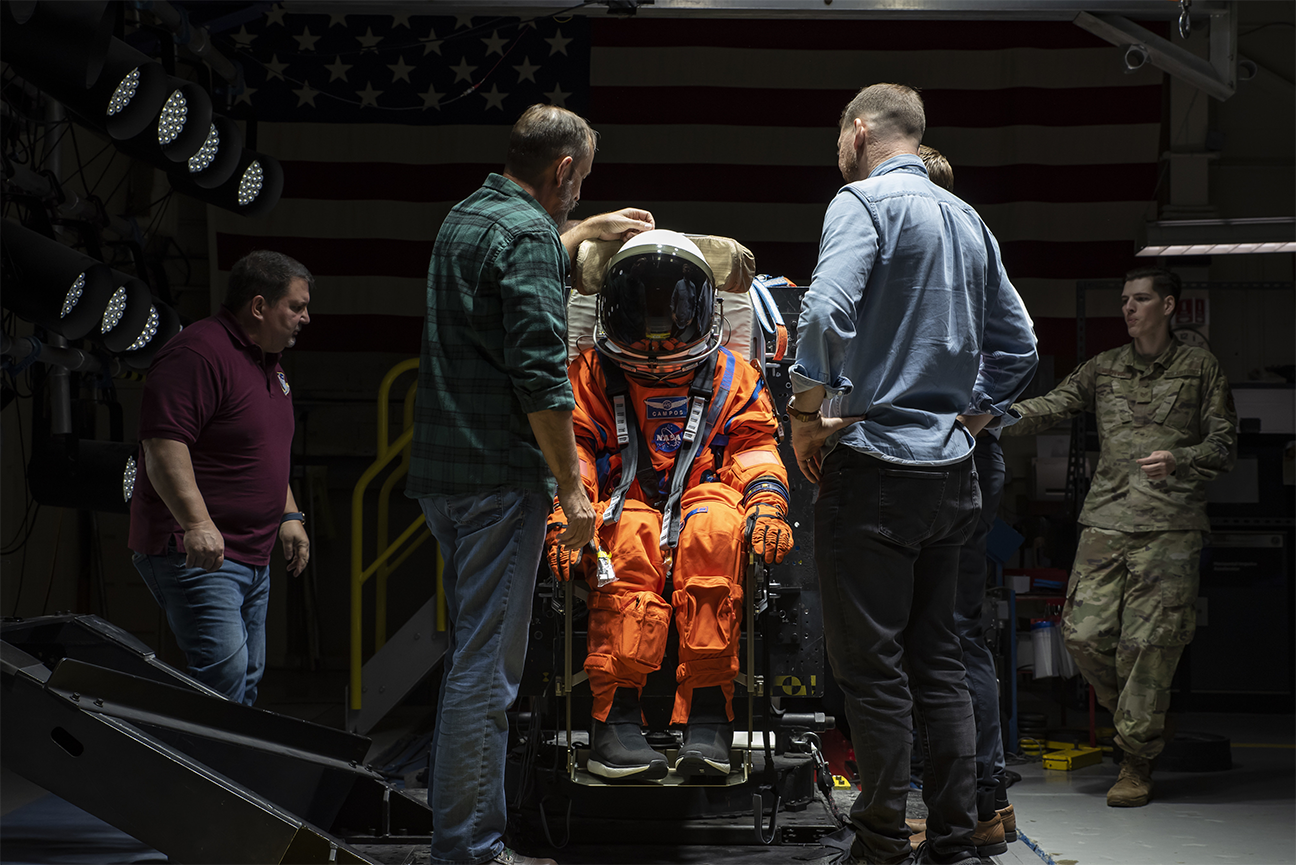
The Air Force Research Laboratory, or AFRL, and NASA staff adjust Campos, a fire and rescue training manikin, in the seat at the sled test facility at Wright-Patterson Air Force Base, Ohio, April 17, 2023. AFRL and NASA, along with other industry partners, such as Lockheed Martin, tested the most current iteration of an astronaut crew seat and flight suit that will be used on the Orion spacecraft during the next mission to the moon under the Artemis Program. The manikin used in the testing was Campos, named after the legendary Arturo Campos, an electrical engineer who was instrumental to saving the Apollo 13 crew. Campos is accurately weighed and has the appropriate density of a human for testing. (U.S. Air Force photo / Rick Eldridge)
“A space capsule comes in under dynamic conditions,” Gohmert said. “Every landing is effectively a controlled crash. Who better to test these kinds of things than the Air Force Research Laboratory?”
The technology has significantly advanced since the days of the Apollo program, but the physics are the same, Gohmert said. Artemis now has tools that make the physics much easier to accomplish. Adapting and using newer technologies was a big part of what the Artemis team has done so far.
“While we have a leg up on the process, we are also trying to take everything to a much higher level of detail and complexity than the Apollo mission considered,” Gohmert said.
The principles of keeping humans alive when going into and returning from space have not changed, but the techniques have been updated so the same tasks can be accomplished with lighter materials, more advanced guidance systems and better regeneration of habitations, Gohmert said.
“We were led here from the testing capabilities that are here but also from the previous research over the years,” Gohmert said. “It provides unique insight for things like ejection seats that applied to us much more than crash test data.”
The idea behind the facilities and research is to help provide data to improve injury criteria and ensure occupants can fly safer, Perry added.
“Another objective is to actually work with trying to design hardware or improve hardware. So, improve the seat or make a modification to the restraint system, so the occupant [is] protected from an adverse environmental event — ejection or crash,” Perry said.
NASA’s Artemis program is a series of increasingly complex missions meant to enable a long-term human presence on the Moon and, eventually, crewed missions to Mars. In November of 2022, Artemis I marked the first uncrewed test flight of the Orion spacecraft, utilizing the Space Launch System, or SLS, rocket and the ground systems at Kennedy Space Center in Cape Canaveral, Florida.
The Artemis II test flight, scheduled to launch no earlier than November 2024, will be NASA’s first crewed flight to the Moon since the end of the Apollo program in 1975. During the roughly 10-day mission, the four astronauts will confirm that Orion’s life support systems and other components are operating as intended.
Orion will then perform multiple maneuvers to raise its orbit and perform a lunar flyby and enter a lunar free return trajectory to Earth — Earth’s gravity will pull Orion back. Artemis II is meant to pave the way to land humans on the Moon once again on Artemis III, scheduled to launch in December 2025.
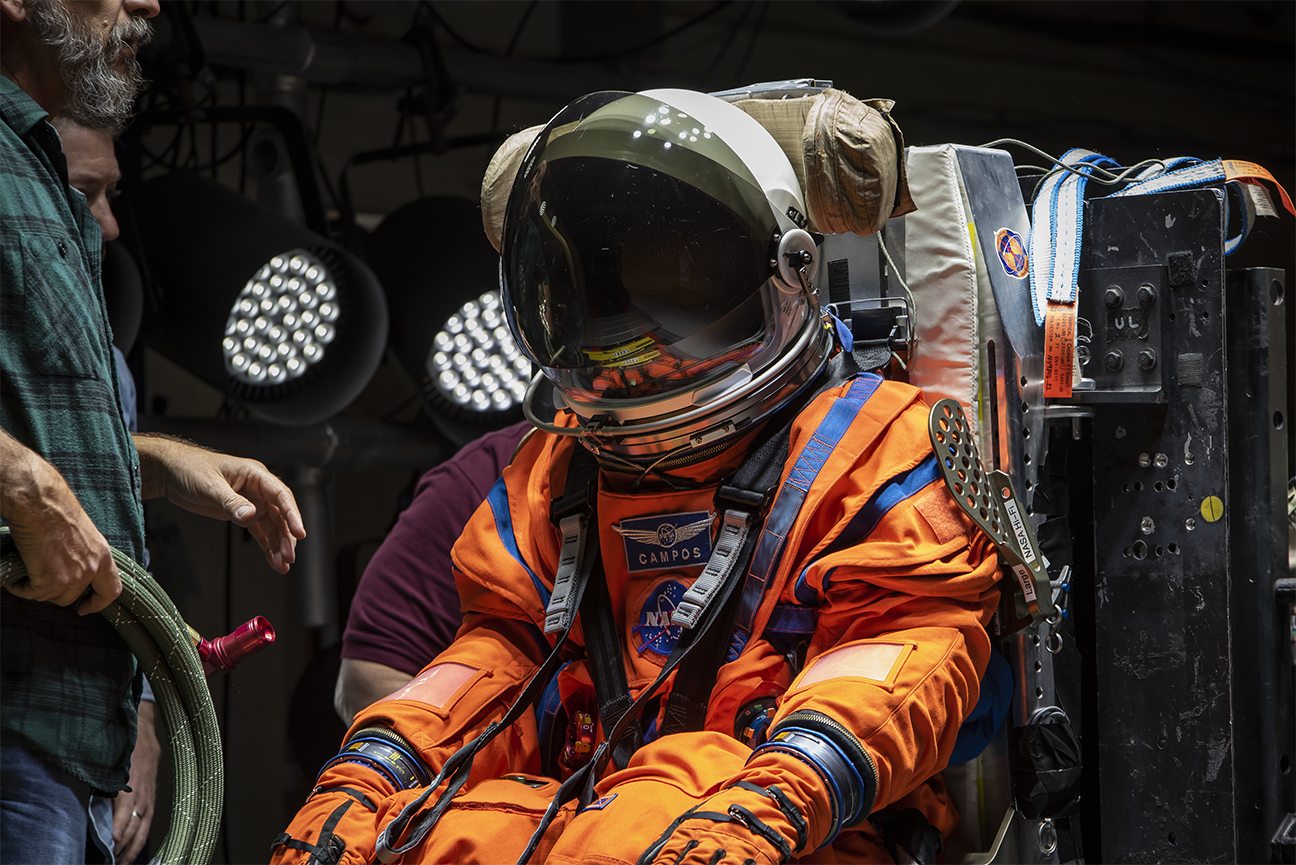
The Air Force Research Laboratory, or AFRL, and NASA staff prepare Campos, a fire and rescue training manikin, in the seat at the sled test facility at Wright-Patterson Air Force Base, Ohio, April 17, 2023. AFRL and NASA, along with other industry partners, such as Lockheed Martin, tested the most current iteration of an astronaut crew seat and flight suit that will be used on the Orion spacecraft during the next mission to the moon under the Artemis Program. The manikin used in the testing was Campos, named after the legendary Arturo Campos, an electrical engineer who was instrumental to saving the Apollo 13 crew. Campos is accurately weighed and has the appropriate density of a human for testing. (U.S. Air Force photo / Rick Eldridge)
About AFRL
The Air Force Research Laboratory, or AFRL, is the primary scientific research and development center for the Department of the Air Force. AFRL plays an integral role in leading the discovery, development and integration of affordable warfighting technologies for our air, space and cyberspace force. With a workforce of more than 11,500 across nine technology areas and 40 other operations across the globe, AFRL provides a diverse portfolio of science and technology ranging from fundamental to advanced research and technology development. For more information, visit www.afresearchlab.com.


